The Landscape Lighting Market is estimated to be valued at USD 14.8 billion in 2025 and is projected to reach USD 34.7 billion by 2035, registering a compound annual growth rate (CAGR) of 8.9% over the forecast period.
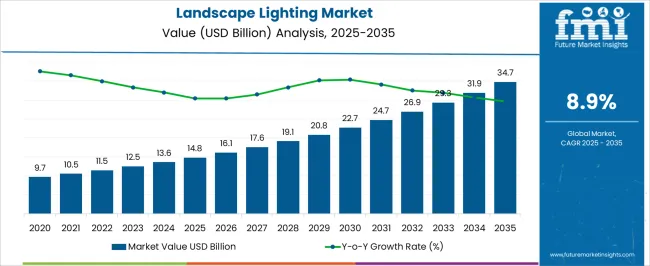
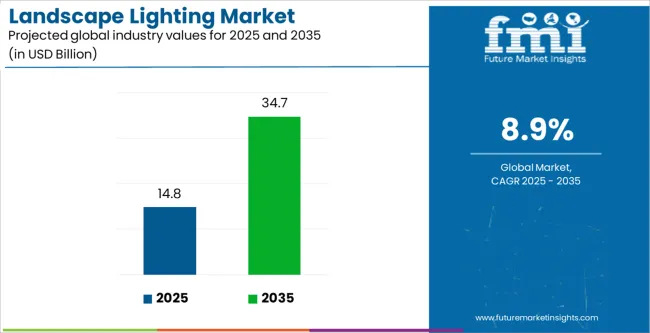
| Metric | Value |
|---|---|
| Landscape Lighting Market Estimated Value in (2025 E) | USD 14.8 billion |
| Landscape Lighting Market Forecast Value in (2035 F) | USD 34.7 billion |
| Forecast CAGR (2025 to 2035) | 8.9% |
The Landscape Lighting market is expanding steadily, supported by rising demand for sustainable outdoor illumination and the integration of smart technologies into lighting systems. In 2025, growth is being influenced by increasing investments in urban beautification projects, outdoor recreational infrastructure, and energy-efficient lighting solutions. The widespread adoption of eco-friendly lighting technologies is contributing to reduced energy consumption, aligning with global initiatives to lower carbon emissions.
Advances in connectivity, including wireless controls and sensor-based automation, are enabling efficient management of outdoor lighting while enhancing aesthetic appeal and safety. The market is further benefiting from heightened interest in outdoor living spaces and the need for security-focused illumination in both residential and commercial properties.
As cities continue to modernize and sustainable infrastructure becomes a priority, landscape lighting is expected to evolve into a multifunctional solution that addresses energy efficiency, safety, and aesthetic value simultaneously This outlook positions the market for sustained growth in the coming decade, with significant opportunities for manufacturers offering innovative and customizable lighting systems.
The landscape lighting market is segmented by lighting type, application, end user, and geographic regions. By lighting type, landscape lighting market is divided into High-Emitting Diode (LED) light, High-Intensity Discharge (HID) lamps, Fluorescent lights, Plasma lamps, and Others. In terms of application, landscape lighting market is classified into Gardens, parks, Streets, Highways, Parking lots, Business parks, Stadiums, Tunnels, and Others. Based on end user, landscape lighting market is segmented into Commercial, Residential, and Industrial. Regionally, the landscape lighting industry is classified into North America, Latin America, Western Europe, Eastern Europe, Balkan & Baltic Countries, Russia & Belarus, Central Asia, East Asia, South Asia & Pacific, and the Middle East & Africa.
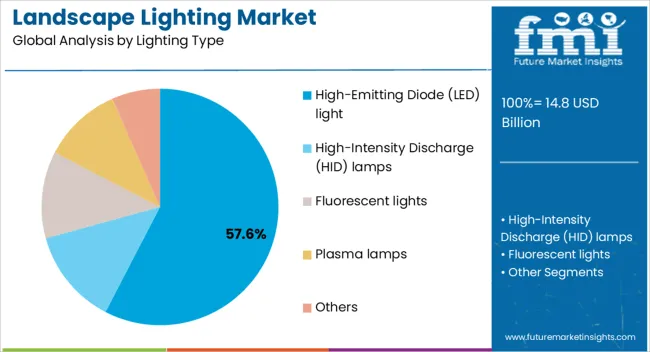
The High-Emitting Diode light segment is projected to hold 57.60% of the Landscape Lighting market revenue in 2025, establishing itself as the dominant lighting type. This position is being driven by the superior energy efficiency, long operational life, and low maintenance requirements of LED technology compared to conventional lighting solutions. The rapid decline in manufacturing costs has further improved the affordability of LED fixtures, making them widely accessible across residential, commercial, and municipal projects.
The segment’s growth is also being supported by increasing government emphasis on sustainable lighting systems that reduce electricity consumption while ensuring high-quality illumination. Enhanced color rendering, design flexibility, and compatibility with smart controls have contributed to LED lights being preferred for outdoor applications where durability and adaptability are crucial.
The ability to integrate sensors and connectivity modules into LED systems allows real-time monitoring and control, increasing their utility in modern landscape projects As energy efficiency regulations tighten globally, the LED segment is expected to maintain its leading role in the landscape lighting market.
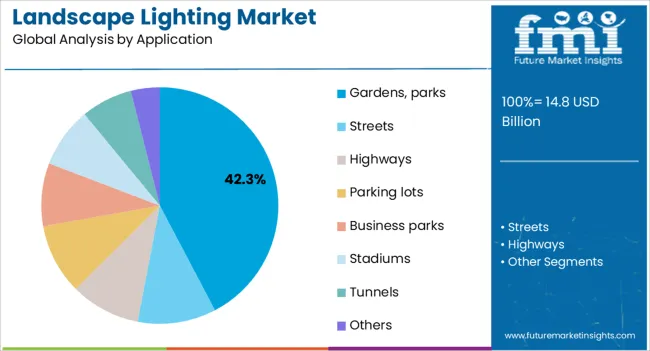
The Gardens and Parks application segment is expected to account for 42.30% of the Landscape Lighting market revenue in 2025, making it the leading application category. This dominance is being attributed to the rising focus on enhancing the visual appeal of public and private green spaces while ensuring safety and usability during evening hours. Urban planners and municipalities are prioritizing the illumination of gardens and parks to support recreational activities, encourage community engagement, and improve environmental aesthetics.
The ability of software-enabled lighting systems to provide programmable brightness, color variations, and automated controls has further advanced the adoption of landscape lighting in these spaces. Increasing investments in urban green infrastructure and eco-tourism have also supported the widespread deployment of lighting solutions in public parks.
Furthermore, the integration of energy-efficient LEDs and solar-powered units has ensured cost savings and sustainability, aligning with long-term infrastructure development goals As cities continue to emphasize livable environments, lighting in gardens and parks is anticipated to remain a primary area of investment in the market.
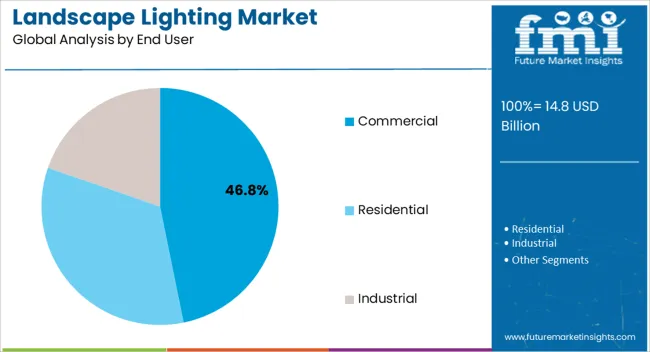
The Commercial end user segment is projected to command 46.80% of the Landscape Lighting market revenue in 2025, making it the largest consumer group. This leading share is being reinforced by the increasing use of landscape lighting in hotels, resorts, shopping complexes, office campuses, and entertainment venues to create visually appealing environments while ensuring security and accessibility. Businesses are leveraging landscape lighting to enhance brand image, improve customer experiences, and extend usability of outdoor spaces beyond daylight hours.
The ability of commercial operators to deploy advanced lighting systems with smart controls and remote monitoring capabilities has further accelerated adoption. Cost savings through energy-efficient solutions, combined with the potential to attract customers through improved aesthetics, are strong drivers for this segment.
Compliance with safety standards and the need for secure, well-lit environments have also contributed to higher investments in commercial applications As commercial infrastructure continues to expand globally, supported by urbanization and tourism growth, the demand for innovative and sustainable lighting systems is expected to sustain the dominant position of this segment.
The development of energy-efficient and economic LEDs lighting products has broaden the application of the LED lights including the outdoors also. Due to advancements in landscape lighting technology, (such as the use of chip-on-board technology) landscape lighting are being adopted significantly. Moreover, the day and night monitoring of the outside environment is done with the help of the landscape lighting.
The landscape lighting market is expected to have a significant growth during the forecast period owing to the promising application of landscape lighting inside the house and in roadways also.
The modern landscape lighting is expected to encourage people to switch from conventional lighting solutions to LED landscape lighting solutions due to the advanced features of the landscape lighting market.
In addition, the arrival of efficient and smart technologies, such as daylight sensors and control systems (for the remote monitoring of smart street lights) provide a rise in potential opportunities for the landscape lighting market.
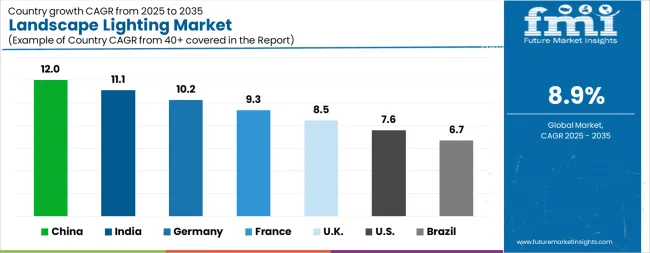
| Country | CAGR |
|---|---|
| China | 12.0% |
| India | 11.1% |
| Germany | 10.2% |
| France | 9.3% |
| UK | 8.5% |
| USA | 7.6% |
| Brazil | 6.7% |
The Landscape Lighting Market is expected to register a CAGR of 8.9% during the forecast period, exhibiting varied country level momentum. China leads with the highest CAGR of 12.0%, followed by India at 11.1%. Developed markets such as Germany, France, and the UK continue to expand steadily, while the USA is likely to grow at consistent rates. Brazil posts the lowest CAGR at 6.7%, yet still underscores a broadly positive trajectory for the global Landscape Lighting Market. In 2024, Germany held a dominant revenue in the Western Europe market and is expected to grow with a CAGR of 10.2%. The USA Landscape Lighting Market is estimated to be valued at USD 5.4 billion in 2025 and is anticipated to reach a valuation of USD 11.3 billion by 2035. Sales are projected to rise at a CAGR of 7.6% over the forecast period between 2025 and 2035. While Japan and South Korea markets are estimated to be valued at USD 701.5 million and USD 418.1 million respectively in 2025.
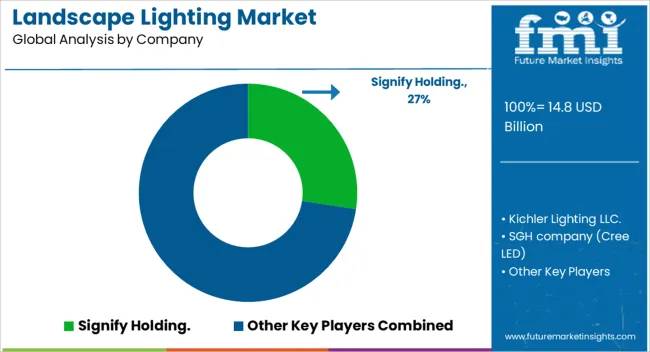
| Item | Value |
|---|---|
| Quantitative Units | USD 14.8 Billion |
| Lighting Type | High-Emitting Diode (LED) light, High-Intensity Discharge (HID) lamps, Fluorescent lights, Plasma lamps, and Others |
| Application | Gardens, parks, Streets, Highways, Parking lots, Business parks, Stadiums, Tunnels, and Others |
| End User | Commercial, Residential, and Industrial |
| Regions Covered | North America, Europe, Asia-Pacific, Latin America, Middle East & Africa |
| Country Covered | United States, Canada, Germany, France, United Kingdom, China, Japan, India, Brazil, South Africa |
| Key Companies Profiled | Signify Holding., Kichler Lighting LLC., SGH company (Cree LED), Acuity Brands, Inc., Hubbell, OSRAM GmbH, Zumtobel Group, Virtual Extension, Eaton, and SAVANT TECHNOLOGIES LLC. (GE) |
The global landscape lighting market is estimated to be valued at USD 14.8 billion in 2025.
The market size for the landscape lighting market is projected to reach USD 34.7 billion by 2035.
The landscape lighting market is expected to grow at a 8.9% CAGR between 2025 and 2035.
The key product types in landscape lighting market are high-emitting diode (led) light, high-intensity discharge (hid) lamps, fluorescent lights, plasma lamps and others.
In terms of application, gardens, parks segment to command 42.3% share in the landscape lighting market in 2025.






Our Research Products

The "Full Research Suite" delivers actionable market intel, deep dives on markets or technologies, so clients act faster, cut risk, and unlock growth.

The Leaderboard benchmarks and ranks top vendors, classifying them as Established Leaders, Leading Challengers, or Disruptors & Challengers.

Locates where complements amplify value and substitutes erode it, forecasting net impact by horizon

We deliver granular, decision-grade intel: market sizing, 5-year forecasts, pricing, adoption, usage, revenue, and operational KPIs—plus competitor tracking, regulation, and value chains—across 60 countries broadly.

Spot the shifts before they hit your P&L. We track inflection points, adoption curves, pricing moves, and ecosystem plays to show where demand is heading, why it is changing, and what to do next across high-growth markets and disruptive tech

Real-time reads of user behavior. We track shifting priorities, perceptions of today’s and next-gen services, and provider experience, then pace how fast tech moves from trial to adoption, blending buyer, consumer, and channel inputs with social signals (#WhySwitch, #UX).

Partner with our analyst team to build a custom report designed around your business priorities. From analysing market trends to assessing competitors or crafting bespoke datasets, we tailor insights to your needs.
Supplier Intelligence
Discovery & Profiling
Capacity & Footprint
Performance & Risk
Compliance & Governance
Commercial Readiness
Who Supplies Whom
Scorecards & Shortlists
Playbooks & Docs
Category Intelligence
Definition & Scope
Demand & Use Cases
Cost Drivers
Market Structure
Supply Chain Map
Trade & Policy
Operating Norms
Deliverables
Buyer Intelligence
Account Basics
Spend & Scope
Procurement Model
Vendor Requirements
Terms & Policies
Entry Strategy
Pain Points & Triggers
Outputs
Pricing Analysis
Benchmarks
Trends
Should-Cost
Indexation
Landed Cost
Commercial Terms
Deliverables
Brand Analysis
Positioning & Value Prop
Share & Presence
Customer Evidence
Go-to-Market
Digital & Reputation
Compliance & Trust
KPIs & Gaps
Outputs
Full Research Suite comprises of:
Market outlook & trends analysis
Interviews & case studies
Strategic recommendations
Vendor profiles & capabilities analysis
5-year forecasts
8 regions and 60+ country-level data splits
Market segment data splits
12 months of continuous data updates
DELIVERED AS:
PDF EXCEL ONLINE
Lighting As A Service Market Size and Share Forecast Outlook 2025 to 2035
Lighting as a Service (LaaS) Market Size and Share Forecast Outlook 2025 to 2035
Lighting Product Market Size and Share Forecast Outlook 2025 to 2035
Lighting Contactor Market Growth – Trends & Forecast 2024-2034
Lighting Fixture Market
EV Lighting Market Growth - Trends & Forecast 2025 to 2035
LED Lighting Controllers Market
Strobe Lighting Market Size and Share Forecast Outlook 2025 to 2035
Runway Lighting Market Trends, Outlook & Forecast 2025 to 2035
Marine Lighting Market
Runway Lighting System Market
Plasma Lighting Market
Stadium Lighting Market Size and Share Forecast Outlook 2025 to 2035
Outdoor Lighting Market Growth – Trends & Forecast 2025 to 2035
Airport Lighting Market
Aircraft Lighting Market Size and Share Forecast Outlook 2025 to 2035
High End Lighting Market Size and Share Forecast Outlook 2025 to 2035
Hospital Lighting Market Size and Share Forecast Outlook 2025 to 2035
Military Lighting Market Size and Share Forecast Outlook 2025 to 2035
Wireless Lighting Market Size and Share Forecast Outlook 2025 to 2035

Thank you!
You will receive an email from our Business Development Manager. Please be sure to check your SPAM/JUNK folder too.
Chat With
MaRIA